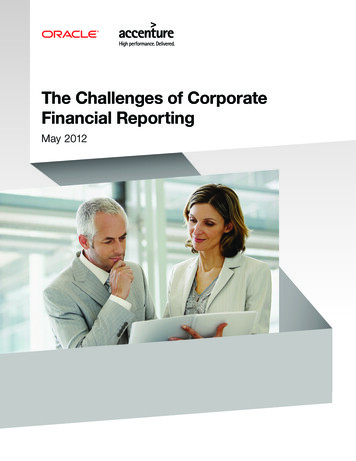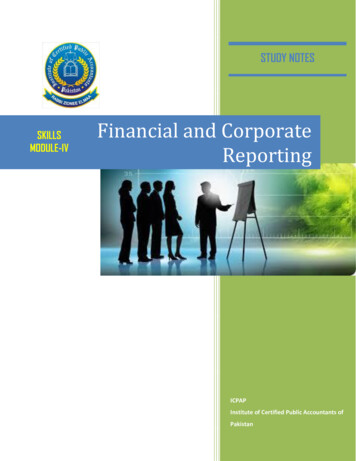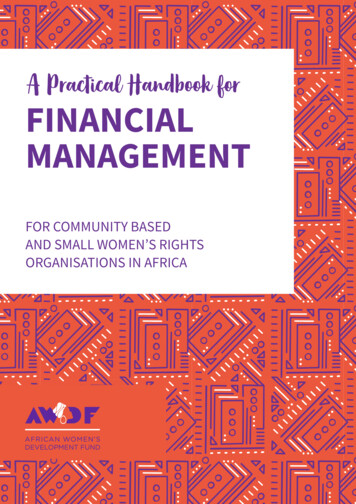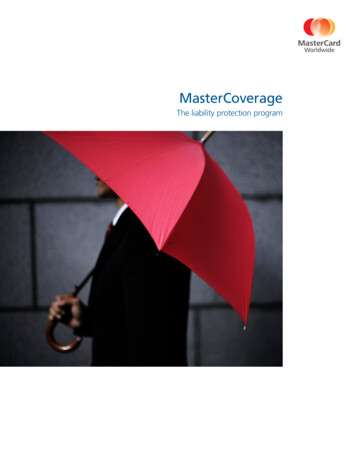
Transcription
The Challenges of CorporateFinancial ReportingMay 2012
Table of contents1Introduction from Oracle2Research Highlights3Executive Summary4Key Findings14A Confident Future?15Methodology16About Accenture16About OracleIBCContacts
The Challenges of Corporate Financial ReportingIntroduction from OracleMany finance professionals face serious challenges in managingand reporting their company’s financial data, despite recentinvestments in financial reporting systems. Oracle and Accenturelaunched this research report to help finance professionals betterunderstand the state of corporate financial reporting today, andwhy recent investments may have fallen short.The study reveals a key central issue: Organizations have beentaking a piecemeal—rather than holistic—approach to investing.Without a vision and strategy that addresses process improvement,data integrity, and user adoption software investments alone willnot meet the needs or expectations of most organizations.The research found that the majority of finance teams in 12countries—including the U.K., USA, France, Germany, Russia, andSpain—have made substantial investments in corporate financialmanagement processes and systems over the last three years.However, many of these solutions, which were expected to improveclose, reporting, and filing processes, are ineffective, resulting in alack of visibility, quality, and confidence in financial data.1
The Challenges of Corporate Financial ReportingResearch Highlights Seeking change: Businesses recognize they need to invest in financial reportingto address the challenges they currently face. 47 percent of companies havemade substantial investments over the last year to the financial close, filing, andreporting processes. Ineffective investments: Despite these investments, spreadsheets (72 percent)and e-mails (68 percent) are still being used daily to track and manage reporting,suggesting that new investments are falling short of expectations. Increased costs and uncertainty: The situation is so opaque that managers acrossthe finance function are unable to fully understand the financial impact or costimplications of reporting, with 60 percent of respondents admitting they did not knowthe total cost of managing and publicizing their financial results. Persistent challenges: 68 percent of respondents admitted that they haveinadequate visibility into reporting processes, while 84 percent of finance managerssurveyed said they find it difficult to control the quality of financial data across theentire reporting process. Decreased effectiveness: 71 percent of finance managers feel their effectivenessis limited in some way by data-analysis–related issues, while 39 percent of C-level orVP-level respondents say their effectiveness is impaired by limited visibility. Missed deadlines: Due to late changes to the chart of accounts, 15 percent of globalbusinesses have missed statutory filings, putting their companies at risk of financialpenalties and potentially impacting share value.The report makes it clear that investments made to date by these large organizationsaround the world have been uneven across the close, reporting, and filing processes,which has led to the challenges these organizations currently face in managing theirfinancial data. Regardless of whether companies are using a variety of solutions or asingle solution, the report shows they continue to witness increased costs, ineffectualdata management, and missed reporting, which—in extreme circumstances—can impacta company’s corporate image and share value.The good news is that businesses realize that these problems persist and plan to investfurther to address these issues. While they should invest, it is critical that they direct investments correctly so that data integrity issues are identified and addressed, processesare optimized, and financial reporting is improved through the application of a feature-rich,integrated financial close and reporting solution.With guidance on how to implement the correct business processes, infrastructure, andsoftware solutions, financial teams will find that their reporting processes are much moreeffective, cost-efficient, and aligned with their performance expectations.2
The Challenges of Corporate Financial ReportingExecutive Summary 82 percent of companies have made substantial changes in the last three years to theclose, reporting, and filing processes 47 percent have invested substantially within the last 12 months in at least one ofthese three phases 38 percent currently use a single software tool that covers and links all threephases—but the systems in place seem to fall short in many ways 42 percent use specialist financial close workflow software and 31 percent haveautomatic alerts; 56 percent use one of these tools—but again, such systems fall short 68 percent report inadequate visibility and 84 percent say it is difficult to control thequality of financial data and other supporting information 88 percent have experienced delays in the last 12 months when executing financialclose, reporting, and filing, most of which are due to data-related issues Late changes have affected 80 percent of companies in the last three years, and as adirect result, 22 percent have missed formal reporting deadlines One in five (21 percent) has seen an increase in costs across all three phases in thelast three years, but just 40 percent were able to cite a figure for the total cost of thethree phases during the last fiscal year 86 percent of companies are likely to make a significant investment during the nextfive years, but 40 percent will take a modular approach3
The Challenges of Corporate Financial ReportingKey FindingsBackground and IntroductionThis research set out to investigate the ways in which large companies throughout theworld are managing their finance function and the processes associated with financialclose, reporting, and filing. The questions relate to one or all of the three phases of thefinancial close and reporting process, defined here as:1) Financial close (closing subledgers and general ledgers, collecting and consolidatingfinancial results)2) Financial reporting (preparing and generating financial statements for internal andexternal publication)3) Financial statutory filing (creating, formatting, tagging, and submitting regulatoryfiling to external agencies)The research explores each of the three phases in detail and the relationships and levelsof visibility among them. The findings (covering 12 countries) show that, despiteconsiderable effort and recent investments, finance departments are still struggling todeal with the diverse array of information needed to present accurate and timely financialresults on behalf of their companies.Times of ChangeChanges in the last three years:82 percent of the large companies surveyed have made substantial changes in the lastthree years to the way they approach and manage the three phases of the financial closeand reporting process (close, reporting, and filing).40 percent have addressed just one of these elements, while 21 percent have changedtwo. 21 percent have tackled all three—and this all-encompassing approach has beenmore common in the U.S. (32 percent) and the Middle East (43 percent) compared to theBenelux countries and South Africa (both 6 percent). Industry sectors where an all-ornothing approach has been more common include manufacturing and engineering (26percent) and financial services (23 percent), compared to the retail sector (13 percent).However, for the whole sample, the financial phase most commonly changed is thereporting element (61 percent), while equal proportions of companies have changed thefinancial close and filing processes (both 42 percent—see chart 1).4
The Challenges of Corporate Financial ReportingChart 1: Areas that have undergone substantial changes in the last three years.Whole 33Middle East51Nordics4159Russia4163South 4112205436196640621414100%Financial filings10105044Finanical reporting1313 1437150%3465472501443SpainFinancial close6166150%None of these200%of sampleDon’t knowRecent investment:Such change seems to have been backed by investment, with 47 percent of companieshaving invested substantially within the last 12 months. 12 percent have invested in justone of the three phases during this time, and 10 percent have invested in two of them.25 percent have invested in all three.Looking across the countries in the last 12 months, investments have been especiallycommon in the U.K. (58 percent), Russia (64 percent), and Spain (58 percent). They havealso been more common in the financial services sector where 64 percent have investedduring this time compared to the other sectors (30 percent to 46 percent). Indeed, morerespondents in the financial services sector (37 percent) have invested in all three phasesduring this time, compared to almost all the other industry sectors (4 percent to 23 percent).5
The Challenges of Corporate Financial ReportingTable 1: Timing of Most-Recent Substantial InvestmentPhaseEver invested?Invested in last12 months?Invested more thanthree years ago?Average timeelapsedMedian timeelapsedClose85%38%17%3.3 years ago3 years agoReporting86%36%16%3.2 years ago2 years agoFiling78%33%13%3 years ago2 years agoFor the whole sample, a greater proportion of companies have invested within the last12 months in the close process (38 percent) than in reporting (36 percent) and filing (33percent)—see table 1. However, reporting and filing have received investments slightlymore recently than the close process, on average. This research also shows that a minority of companies have not invested in these areas for more than three years (13 percentto 17 percent).Tools in place:What have these organizations been spending their money on? The research showsthat 98 percent of finance organizations use some sort of software and/or system toassist with the financial close, reporting, and filing tasks. One-third of the companies(33 percent) use specialist financial consolidation software and 37 percent use specialist financial reporting software, while one in four (24 percent) use specialist software toassist with statutory filing.However, another 38 percent say they use a single software tool that covers and links allthree phases of the process. A comparison by country finds that one in two companies(54 percent) in Russia use such a tool, compared to one in four in the U.K. (25 percent).Among industry sectors, such a system is most common in the utilities sector (47 percent), but it is least common in retail (29 percent) and telecoms, high tech, and communications (27 percent).However, even with these specialist systems or solutions in place, 67 percent ofcompanies still use spreadsheets, and 8 percent use spreadsheets and nothing else toassist with tasks in financial close, reporting, and filing. Interestingly, while more peoplewith three separate solutions use spreadsheets (73 percent), a significant 59 percent ofpeople with a single solution also use them.6
The Challenges of Corporate Financial ReportingOutstanding ChallengesIt’s all about the data:A key part of a finance professional’s job is to gather financial data; however, on average,just 65 percent of the data needed for regulatory filing, for example, is financial while 35percent is actually nonfinancial. But there is significant variation among companies, withas many as 28 percent saying over half the data needed is nonfinancial.One of the issues that finance professionals face is consistency, and the more disparatea company is the harder it is to control this aspect. Indeed, one example is the chart ofaccounts, where 88 percent of finance managers say changes to them cause problemsacross the business for the finance team when it comes to closing the books. On average, it takes a company 21 man-days to reconcile and update the chart of accounts, andthe average figure is much higher for companies with international offices (26.8 mandays), compared to those with just national offices (13.5 man-days).It is not surprising then that 84 percent of finance managers say it is difficult to controlthe quality of financial data and other supporting information across the entire process,from close to filing.Managing the process:Responsibility for keeping track of the people, processes, and data seems to fall mainlyon the CFO or VP of finance, although finance and nonfinance managers at other levelsof seniority are also involved.The research shows that to manage this process, 42 percent of companies use specialistfinancial close workflow software, which is especially common in Germany and Nigeria(both 58 percent). In addition, 31 percent have automatic alerts to show when deadlinesare in jeopardy, and alerts of this nature are more common in the U.S. (41 percent) and infinancial services companies (38 percent). Indeed, 56 percent of companies have one or theother of these specialist tools, but only 17 percent rely on just these two and nothing else.Another 40 percent use specialist project management software (such as Microsoft Project).Yet despite the specialist software in place, spreadsheets (72 percent) and e-mails (68percent) are used predominantly by finance teams to track and manage daily progressduring the three phases, and 86 percent use one or both of these methods. In addition,52 percent use the telephone, while 54 percent schedule face-to-face meetings. 40percent attempt to control the process using simple, manual task lists.7
The Challenges of Corporate Financial ReportingVisibility issues:Given the way the process is managed, it is perhaps not surprising that 68 percent ofrespondents think they have inadequate visibility in at least one of the three phases.However, inadequate visibility is most common for financial reporting (43 percent),whereas 35 percent have poor visibility for the filing process and almost as many (32percent) have inadequate visibility for the financial close process.The research shows that visibility seems almost as poor for those with alerts and/orspecialist workflow management software, with 65 percent of those with one of thesesolutions having visibility issues. This is slightly better than those without such technicalsupport (72 percent).Chart 2: Inadequate visibility across the three phases.Whole sample32433529Single 0%Financial close20%Finanical reporting40%60%Financial filings80%None of these100%120%333140%of sampleDon’t knowFurthermore, whether a company has a single software tool that is supposed to coverand link all three phases or whether they have an array of piecemeal solutions (see chart2), they have visibility problems. In fact, 68 percent of those with a single software solution have visibility problems in at least one of these phases and 15 percent experiencethe problem across all three.Inadequate visibility is especially common in finance organizations in the Middle East (92percent) and Nigeria (88 percent), but more finance managers in the U.S. (19 percent)and Nigeria (20 percent) think this applies to all three phases. Only 3 percent in Italyreported the same experience. Looking across industry sectors, the same is true forfinancial services (74 percent), and natural resources and oil and gas sectors (84 percent).8
The Challenges of Corporate Financial ReportingLimiting data:When all the relevant data is gathered, the finance managers have to perform analysis onthe data collected. 71 percent of finance managers believe their effectiveness is limitedin some way by data-analysis–related issues.At the top of the list is a limited ability to perform what-if scenarios on data (34 percent),but 32 percent feel hindered by a limited ability to perform drill-down analyses and 31percent say their effectiveness is impaired by a limited ability to answer nonroutine,unstructured questions.DelaysCauses of delays:It seems finance executives have their work cut out for them, as 88 percent of companies have experienced delays in the last 12 months when executing financial close, reporting, and filing. 70 percent have suffered delays due to data-related issues, including: Data collection and integration (38 percent) Data validation (36 percent) Dealing with multiple data sources (31 percent) Integrating financial and nonfinancial data (18 percent)The research shows that delays have been as common for those with alerts and/orspecialist workflow management software (tools designed to help reduce delays), with86 percent of this group having experienced delays in the last 12 months, compared to89 percent of those without these technical supports. Indeed, delays have been ascommon for those with a single software tool covering and linking the three phases,where delays have been caused by a lack of visibility (22 percent), data collection andintegration issues (38 percent), data validation (38 percent), dealing with multiple datasources (32 percent), account reconciliation (29 percent), audit trails (28 percent),integrating financial and nonfinancial data (22 percent), and XBRL/iXBRL tagging (13percent), among others.9
The Challenges of Corporate Financial ReportingConsequences of late changes:Last-minute changes are often a root cause of delays and during the last three years, 80percent of companies have experienced consequences as a direct result of late changesoccurring in the close, reporting, and filing phases (see chart 3). One in two (54 percent)has missed deadlines of one sort or another, while 42 percent have missed internal deadlines. 22 percent also have actually missed formal reporting deadlines.Chart 3: Consequences of late changes in the last three years.Whole sampleManufacturingand engineering2423Transportand travelRetail2031Natural resources,oil and gas33Telecoms, high tech,and communications1723221543302328Costly delaysReduced productivity of the finance teamInternal deadlines have been missedFormal reporting deadlines have been missed50%16264525916923100%710 1111921419131913 262926360%1013254912 care andlife sciences422526Financial services,including insuranceOther services, includingprofessional services2642422142 9 29 42621219150%of sampleFormal statutory filings have been missedPeople have lost their jobsOtherNone1112 42681416
The Challenges of Corporate Financial ReportingIndeed, 32 percent have failed to meet formal financial presentation commitments of onesort or another and, on top of the 22 percent who have missed formal reporting deadlines, another 15 percent have missed statutory filing during the last three years. In fact,missed formal reporting deadlines have been especially common in the U.S. (27 percent),Italy (29 percent), Russia (27 percent), and Nigeria (30 percent). See chart 4.In addition, 26 percent of companies say late changes have reduced the productivity ofthe finance team and a similar number (24 percent) say late changes have resulted incostly delays.Chart 4: Consequences of late changes by 7Spain20Nigeria2316291026 28 222441450%Costly delaysReduced productivity of the finance teamInternal deadlines have been missedFormal reporting deadlines have been missed6 219161481415218185201151210 4 ermanyRussia501924201465414216181712 2118430100%132150%8 2 10 2200%of sampleFormal statutory filings have been missedPeople have lost their jobsOtherNone11
The Challenges of Corporate Financial ReportingConcerns over missing deadlines:Among the 80 percent of companies that have experienced problems due to latechanges, 62 percent say the board’s trust in the finance department has been reducedas a result. 75 percent would fear the personal impact, including backlash from the board(29 percent) and a loss of confidence in the finance team among board members (40percent)—and the latter applies to one in two (49 percent) of C-level and VP-level respondents.In contrast, fewer respondents (57 percent) would worry about the external impact onthe company, with 22 percent concerned about the reprisal from the financial markets,30 percent worried about bad publicity, and 35 percent concerned about the potentialdamage to the organization’s reputation.Cost, Time, and EffortThe research shows that costs have been rising over the last three years across the threephases of the financial presentation process (see table 2). Indeed, one in five companies(21 percent) have seen an increase in costs across all three areas.Table 2: Changes to Costs in the Last Three Years Across the Three Phases12PhaseHave seencosts sePercentage that Percentagestayed the same that %100%44%14%Filing31%15%10%100%46%14%
The Challenges of Corporate Financial ReportingIn detail, roughly one-third of companies have seen an increase in the cost of each ofthe three phases, and the average increase has been similar across each phase. Only aminority has seen a decrease, while just under half have seen costs remain static overthis three-year time period.What is the total cost burden to an organization of managing and publicizing its financialresults? When asked, just 40 percent of finance managers were able to cite a figure, suggesting they actually have a poor grasp of this issue, with 60 percent admitting they donot know the total cost to their organization.Finance professionals have a better grasp of how a company’s time and effort are distributed among the three phases—and, most of the time, it’s on the close process, whereon average 40 percent of the total amount of time in man-hours is spent. However, this isfollowed closely by the reporting phase, where on average 35 percent of the total time isspent. Just 26 percent of the total time is spent on financial filing.In terms of the future, 36 percent of companies anticipate the cost of the financial reporting phase will increase over the next five years, and this group estimates a 21 percentrise on today’s costs on average. However, one in two (48 percent) believes the cost willremain static, whereas only 10 percent anticipate a decrease in the cost.This is despite the fact that 89 percent of these financial professionals think the widespread adoption of electronic reporting standards, such as XBRL and iXBRL, is inevitable,and on average people expect this to be widespread within 2.4 years. Indeed, 18 percentanticipate such widespread adoption as soon as the end of 2012 and 61 percent anticipate such levels of adoption within the next three years.13
The Challenges of Corporate Financial ReportingA Confident Future?Despite the internal and external changes imposed on the financial close, reporting,and filing processes in the last three to five years and the various problems they haveencountered, most finance managers (63 percent) say their confidence level in their company’s ability to produce accurate financial information on time has remained the same.But 25 percent describe themselves as more confident now, whereas just 11 percent saytheir confidence level has decreased.Despite this confidence and the recent changes and investments already made, theresearch shows that companies have not perfected their processes and the tools theyhave in place to support them. Indeed, 86 percent of companies are likely to make asignificant investment during the next five years in some area of the overall process. Infact, 46 percent will overhaul all three phases together. In contrast, 40 percent will takea piecemeal approach with 21 percent investing in the financial close process, whileanother 26 percent will address the financial reporting element and 17 percent will tacklethe financial filing stage.The research also shows that among those who will make a significant investment in thenext five years by overhauling all three phases together, 26 percent have already madesubstantial changes to all three areas during the last three years. This and other elementsof the research suggest that many of those with an all-encompassing solution or systemin place have not yet taken advantage of the opportunities it offers and realize that furtherinvestment will be necessary to achieve their goals.14
The Challenges of Corporate Financial ReportingMethodologyThis research was commissioned by Oracle and Accenture and details quantitativeresearch with 1,123 finance professionals in large organizations in 12 countries aroundthe world. All respondents confirmed their level of seniority prior to being interviewed.They also indicated that their company had at least 250 employees. The size of the countrysamples roughly reflects the size of the individual countries’ economies (see table 3).Table 3: Sample Sizes Across the CountriesCountrySample sizeCountrySample sizeU.K.118Middle uth Africa101Germany101Spain50Italy101Nigeria50The sample is made up of large companies of different sizes, with almost a quarter (23percent) being very large corporations with annual revenues of more than US 1 billion.Just 15 percent have annual revenue of less than US 100 million. As with size by revenue,there is a good spread of companies of different sizes by number of employees. 48 percent have 250 to 999 employees, while 52 percent have more than 1,000 employees.The vast majority of companies in the sample have multiple sites or offices (84 percent)and among these, 62 percent have sites or offices in other countries, apart from theirown. 54 percent of companies are listed on at least one financial market, whereas 41percent are not. The sample also covers a wide variety of industry sectors and all ofthese sectors are well represented.The sample includes finance respondents at a variety of seniority levels, with 52 percentat senior-manager level or above. This includes 8 percent who operate at C level or VPlevel, 13 percent at director level, and 31 percent at senior-manager level. Another 48percent of the sample operate at middle-manager level.All interviews were conducted between February 10 and March 15, 2012. Before andduring the interviews, respondents were not aware that Oracle had commissionedthe research.This research was carried out by Dynamic Markets on behalf of Oracle and Accenture.Dynamic Markets is a research consultancy in its 14th year of trading. It serves a widevariety of blue-chip B2B and B2C clients across various industry sectors. It strictly adheres to the U.K. MRS Code of Conduct.15
The Challenges of Corporate Financial ReportingAbout AccentureAccenture is a global management consulting, technology services, and outsourcingcompany with approximately 236,000 people serving clients in more than 120 countries.Combining unparalleled experience, comprehensive capabilities across all industries andbusiness functions, and extensive research on the world’s most successful companies,Accenture collaborates with clients to help them become high-performance businessesand governments. The company generated net revenues of US 25.5 billion for the fiscalyear ended August 31, 2011. Its home page is accenture.comAbout OracleOracle (NASDAQ: ORCL) engineers hardware and software to work together in the cloudand in your data center. With more than 380,000 customers—including 100 of theFortune 100—in more than 145 countries around the globe, Oracle is the only vendorable to offer a complete technology stack in which every layer is engineered to worktogether as a single system. Oracle’s industry-leading on-premises and cloud-basedsolutions give customers complete deployment flexibility and unmatched benefitsincluding unbreakable security, high availability, scalability, energy efficiency, powerfulperformance, and low total cost of ownership. For more information, visit oracle.com16
The Challenges of Corporate Financial ReportingContactsReport Coauthor:Oracle Media Contact:Dr. Cherry TaylorManaging DirectorDynamic Markets LimitedTel.: 44 (0) 870 707 6767E-mail: cherry.taylor@dynamicmarkets.co.ukWeb: dynamicmarkets.co.ukWill SturgeonExecutive DirectorCMGRP U.K.Tel.: 44 (0) 20 7067 0600E-mail: WSturgeon@cmgrp.comAccenture Media Contact:Oracle Contact and Coauthor:Nigel YouellProduct Marketing Director—Performance Management ApplicationsOracle CorporationTel.: 44 (0) 0118 9240000E-mail: nigel.youell@oracle.comWeb: oracle.comAccenture Contact and Coauthor:Scott BrennanExecutive DirectorFinance & Enterprise PerformanceAccentureTel.: 1.704.370.5328E-mail: scott.brennan@accenture.comWeb: accenture.comBarbara LyonSenior ManagerCorporate CommunicationsAccentureTel.: 1.703.947.1838E-mail: barbara.d.lyon@accenture.com
Copyright 2012, Oracle and/or its affiliates. All rights reserved.Oracle and Java are registered trademarks of Oracle and/or itsaffiliates. Other names may be trademarks of their respective owners.
3 The Challenges of Corporate Financial Reporting Executive Summary 82 percent of companies have made substantial changes in the last three years to the close, reporting, and fi ling processes 47 percent have invested substantially within the last 12 months in at least one of these three phases 38 percent currently u










